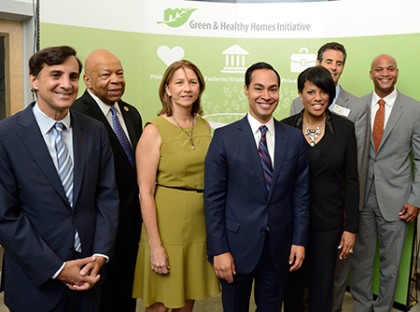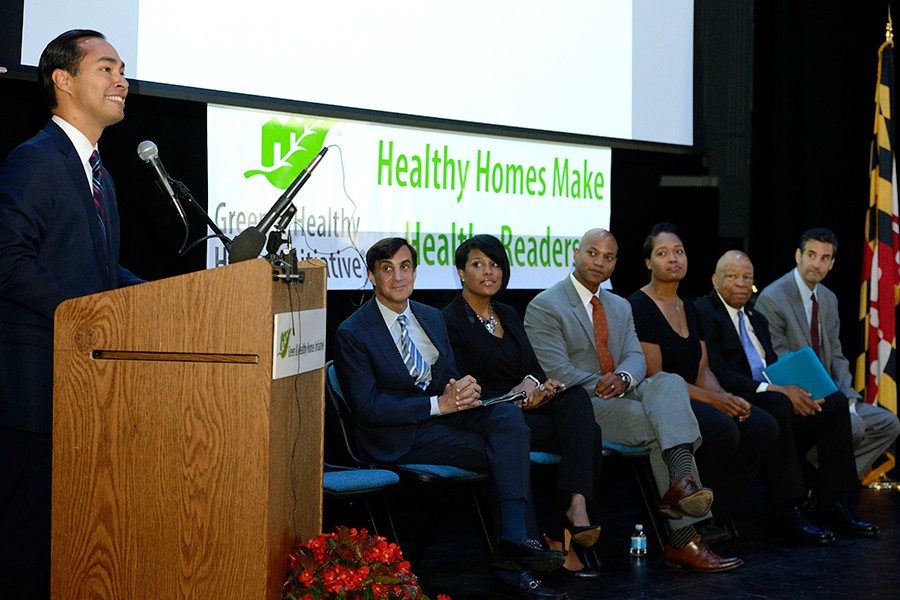At a back-to-school event in East Baltimore this morning, U.S. Housing and Urban Development Secretary Julian Castro joined Baltimore City officials and major philanthropic and nonprofit leaders to call for more action to make homes healthier and safer, giving children better opportunities to stay healthy and succeed in school.

Image caption: Speakers at the event included (from left to right) Johns Hopkins University President Ronald J. Daniels; U.S. Rep. Elijah E. Cummings, Green & Healthy Homes Initiative President Ruth Ann Norton, U.S. Department of Housing and Urban Development Secretary Julian Castro, Baltimore Mayor Stephanie Rawlings-Blake, U.S. Rep. John Sarbanes, and civic activist Wes Moore.
Image credit: Will Kirk / Johns Hopkins University
Castro announced that the Department of Housing and Urban Development has awarded a grant of more than $3.7 million to Baltimore to protect children from lead-based paint and other safety hazards.
"Every family deserves to live in a safe and healthy home where they can see their children thrive and excel," Castro said. "Communities will use these grants to help eliminate home-related hazards in neighborhoods across the country. A healthy home is vital to the American Dream."
The event took place at the Henderson-Hopkins School, which is operated by the Johns Hopkins School of Education. Castro was introduced by Johns Hopkins University President Ronald J. Daniels.
Baltimore Mayor Stephanie Rawlings-Blake, U.S. Rep. Elijah E. Cummings of Maryland, and Baltimore author and civic activist Wes Moore—a 2001 JHU graduate—also attended the event and discussed the critical importance of making homes healthier and safer. Several leaders from national and Baltimore foundations were on hand to stress the connection between healthy homes and student success.
"If our kids are missing school because of asthma or other ailments, or if they arrive here from homes that are full of lead paint, they cannot succeed academically," Daniels said.
"Our university often talks about our role—our obligations—as an anchor institution in Baltimore. But we also welcome and seek out partners who share our aims. The group gathered here today represents a powerful collection of government, nonprofits, and foundations, all focused on the same goals—supporting the children of Baltimore."
Also see: Baltimore to get $4 million to address lead paint in homes (The Baltimore Sun)
Lead, a harmful neurotoxin linked to stunted growth, kidney damage, and delayed development, has been banned from household paints in the U.S. since 1978, but lead paint remains common in Baltimore due the prevalence of poverty and older homes in the city. A 2013 report by the Maryland Department for the Environment noted that 65,000 children in Baltimore were identified as having dangerously high levels of lead in their blood from 1993 to 2013. According to the 2013 data, Baltimore's lead poisoning rate among children under age of 6 is more than twice the national average.
Today's event was hosted by the Baltimore-based Green & Healthy Homes Initiative, the nation's largest organization focused on healthier housing. The group, which is now operating in 25 cities, has worked for three decades to improve living conditions for children, families, and seniors by making systemic home improvements that reduce the risks of lead-paint poisoning, asthma, and other health hazards. The theme for the gathering was "Healthy Homes Makes Healthy Readers."
"By improving energy efficiency, addressing environmental health factors that exacerbate asthma, and fixing hazards like lead paint, we improve grade-level reading scores, reduce school absences, increase a parent's ability to get to work, and lower housing costs," GHHI President and CEO Ruth Ann Norton said. "These investments in proven healthy, safe, and energy-efficient housing interventions simply work. And we have the data to prove that."
GHHI's housing interventions have lowered hospitalizations by more than 65 percent while improving school attendance by 62 percent, Norton said.
The grant to Baltimore is among more than $48 million in Lead Hazard Reduction Demonstration grants awarded to 14 local and state government agencies today by the Department of Housing and Urban Development. The awards are aimed at reducing the number of lead-poisoned children and protecting families by targeting health hazards in nearly 3,200 low-income homes.
In Baltimore, the grant will pay for assessments of 330 homes for lead hazards and other environmental health hazards in Baltimore. Based on the assessments, the grant will help pay for lead hazard control in 230 homes and work to remove other environmental health hazards in 115 homes.
Tagged community, lead poisoning








